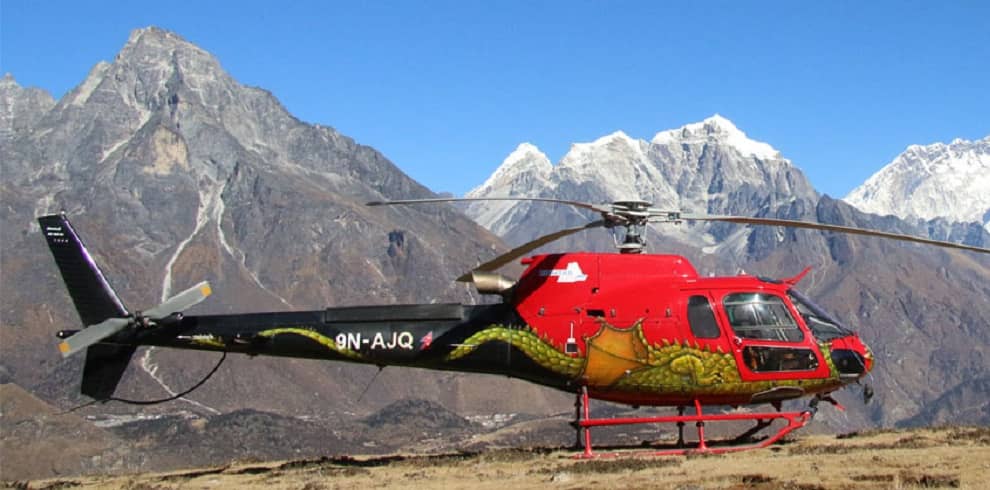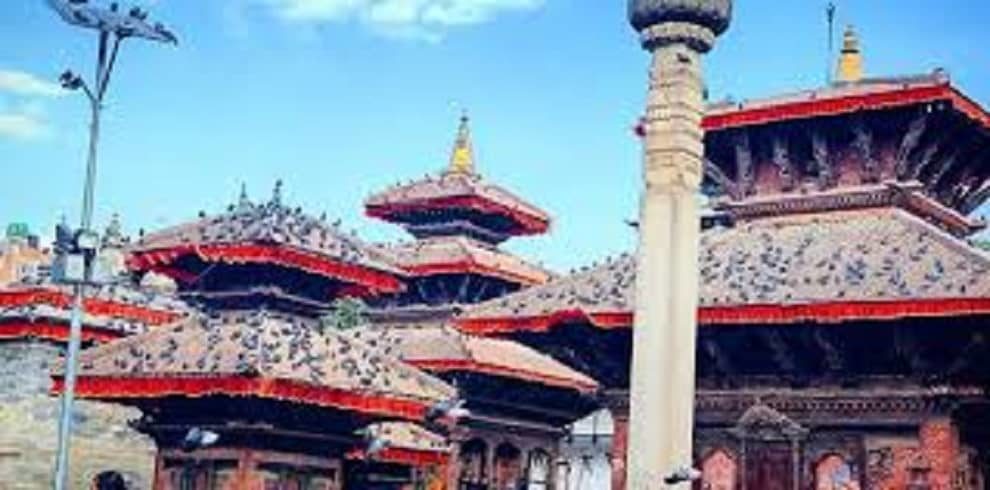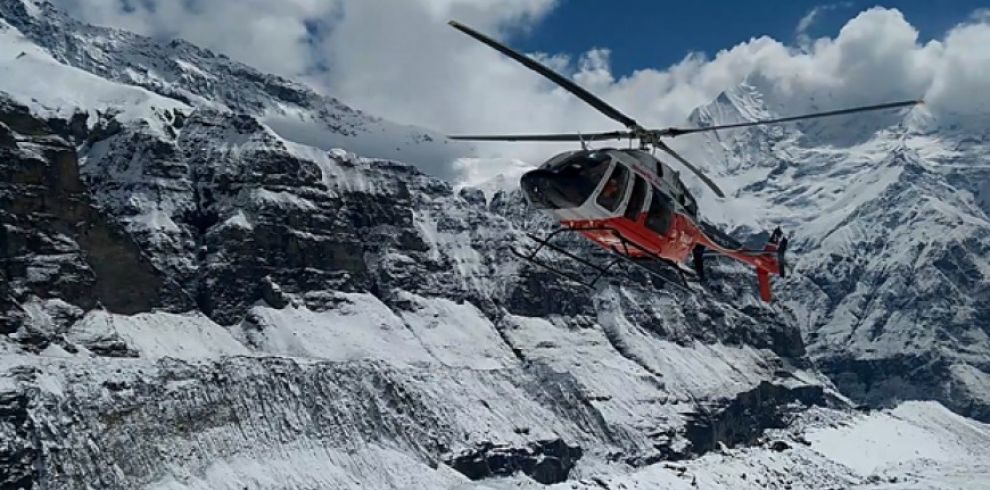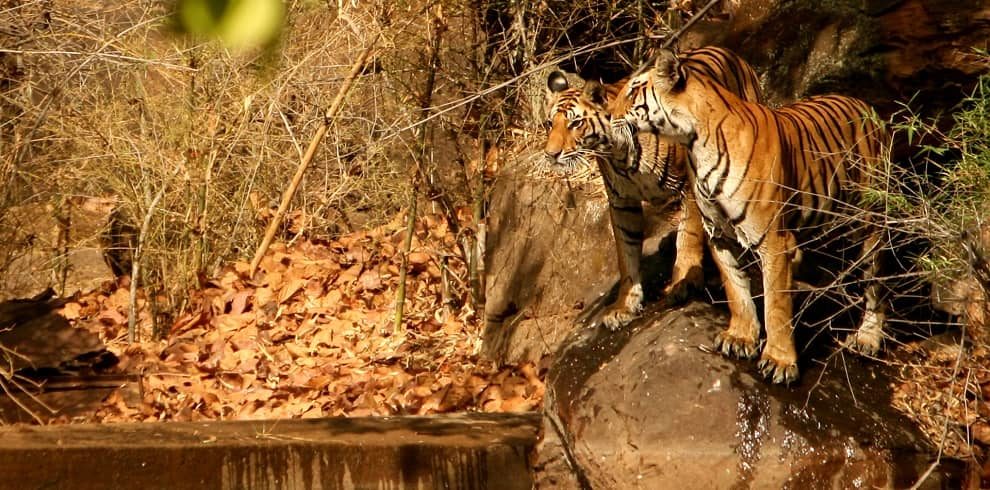Introduction To Everest Base Camp Helicopter Tour In Nepal
Everest Base Camp Helicopter Tour with Kalapattar Landing is a fantastic trip that offers overhead views of practically every treasure in the Everest region.
This plan is for those who want to go to Everest Base Camp in a crisp and refreshing manner, primarily by helicopter. You will spend a total of three days in Phakding and Namche Bazaar, where you will learn about Sherpa culture and customs.
Your travel will be very comfortable because you will be flying over the higher elevations. The journey begins with a picturesque flight from Kathmandu to Lukla in the early morning.
A short climb from Lukla will take you to Phakding (2,650m). The next morning, we travel to Namche Bazaar (3,440m), the Everest gateway. The hike will be enjoyable and exciting because we will cross multiple bridges, including the Hillary Suspension Bridge, on our way to Namche.
We’ll spend one day in Namche acclimating before taking a helicopter to Everest Base Camp. We shall not, however, be idle in Namche. We can hike to Khumjung and/or Sagarmatha National Park.
The Khumjung monastery is said to be home to a yeti scalp. You can also go to Syangboche Airport (3,780m), which is one of the world’s highest airports. You must hike up to Everest Hotel if you want to see Everest. After an acclimatization day in Namche, we take a helicopter to Everest Base Camp.
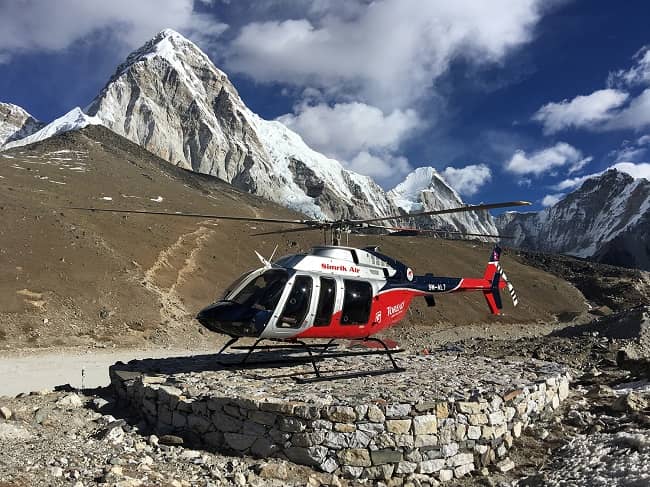
The flight is thrilling, and the sights of snow-capped mountains and high-altitude settlements are breathtaking. You’ll enjoy a bird’s eye view of the entire Everest region, including Gokyo lakes and other high passes, when you stare down from the helicopter. In Kala Patthar, the helicopter will land (5,555m).
The Kala Patthar Viewpoint offers close-up and panoramic views of Mount Everest and other high peaks. Even while Everest Base Camp appears to be the ideal location for seeing Everest, this is not the case.
Because Mount Everest cannot be seen from Everest Base Camp, Kala Patthar is the preferred location for viewing Everest and the surrounding environs. We take the helicopter back to Lukla after taking in the vistas from Kala Patthar. The next day, we’ll fly back to Kathmandu early in the morning.
This journey is for anyone who wishes to view the world’s highest mountain in a short amount of time and with minimal effort.
To attend the trip briefing, we recommend that all of our valued clients arrive at Kathmandu airport before 3 p.m. at least one day prior to the trek departure date. During the trip briefing, we will offer you important trek information and inspect your luggage to verify that you have brought all you need. Furthermore, we recommend adding one or two days to your walk because inclement weather may cause flights to Lukla from Kathmandu or Lukla to Kathmandu to be delayed or canceled. We don’t want you to miss your international trip home as a result of the delay.
Highlights Of Everest Base Camp Helicopter Tour In Nepal
- Flights that are both magnificent and beautiful Lukla-Kathmandu-Kathmandu
- A short hike to Namche Bazaar, the Everest base camp.
- Everest Base Camp is reached via a spectacular and exhilarating helicopter trip.
- Get to know the Sherpa culture and way of life.
- Khumbu Glacier
- Take in the majesty of the Khumbu Icefall (5,486m)
- Graceful views of the world’s highest peaks, Mt. Everest (8,848m), Mt. Lhotse (8,516m), Cho Oyu (8,201m), and Mt. Makalu (8,463m)
Benefits Of Everest Base Camp Helicopter Tour In Nepal
- Free pick-up and drop-off in a private vehicle from the airport to the hotel and vice versa.
- Our trekkers are equipped with medical supplies in case of an emergency.
- At high elevations, we utilize oximeters to check blood oxygen saturation levels. It can detect altitude sickness symptoms early on.
- If you don’t have your own, you can rent down jackets and sleeping bags.
- During the walk, we provide free luggage storage at our store.
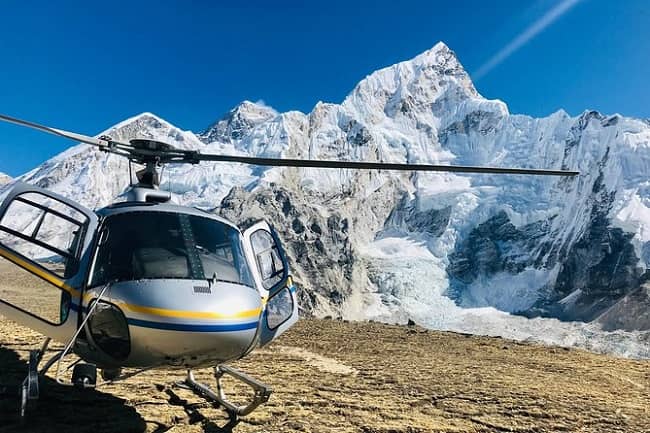
Equipment Checklist
Equipment list for Everest Base Camp Trek
For the trek, we recommend that you bring only the essential clothing and accessories. Although we recognize that you have your own tastes, we have compiled a list to assist you in packing your belongings for the voyage. Your luggage will be carried by porters, however, the weight limit is 9 kilos. In Kathmandu, you can purchase the equipment at a low price.
Head
- Scarf or hat for the sun
- Winter hat, insulating hat, or a hat with a wide brim
- Extra batteries for the headlight
Face
- Sunscreen
- Sunglasses that block UV rays
- Wipes for the face and body
Hands
-
Lightweight gloves
-
Heavyweight winter gloves
Body
- Shirts for hiking
- Shirt with a long sleeve made of synthetic fiber.
- Rain jacket with hood
- Jacket made of fleece
- Cotton pants that are light and airy.
- T-shirt (bring lightweight wool)
- Underwear made of polypropylene
- Jacket with down feathers (available for rent in Kathmandu)
- Sweater
- Jacket and pants that are waterproof
Footwear
- Boots for Hiking
- Socks made of thick wool (Take an extra pair of thick light socks)
Essential gear
- A daypack or a backpack (Size depends on whether you take a porter or not)
- Bottle with a heating element
- Purification of water
- Pole for hiking
- Bag for sleeping (-15 degree bag is best for high altitude trekking)
Toiletries
- a drying towel of medium size
- Toothbrush
- Toothpaste
- Deodorant/floss/toilet paper
- Biodegradable soap in a bar
- a pair of nail clippers
- Mirror, little
Personal accessories
-
Money
-
Watch
-
Cell phone
-
Camera
Extra items
- Kit for first aid
- Extra passport pictures and passport photocopies
- Pencil and notebook
- Binoculars
Trip Information
Journey start
Tribhuvan International Airport, Kathmandu’s only international airport, will welcome you. This package does not include an overnight stay in Kathmandu, which is required. You will fly from Tribhuvan International Airport to Lukla on the day of your trek departure. The flight will take around 40 minutes.
This package includes Kathmandu – Lukla – Kathmandu flights.
Complimentary airport transfer
For clients who have bought the trek package, we provide free airport arrival and departure transfers on any airline. A leaflet with your name and our firm name will be held by our agent.
They will greet you with a khada or marigold garland before transporting you to your accommodation in a private vehicle.
Accommodation details
The Meals
You will be served nutritious and delicious meals on your luxury helicopter journey to Everest Base Camp. Buffets will be served for most breakfasts, lunches, and supper. You’ll have a lot of choices and will almost certainly locate your favorite dishes.
In tea houses, lodges, and cafés, all personal bills (alcoholic, hot (tea/coffee), and cold drinks) are excluded from the package.
Best Time for the Everest Base Camp Helicopter Tour
When planning a helicopter excursion to Everest Base Camp, the weather is the most crucial element to consider. Weather forecasts for Everest Base Camp can be found online, however, they are not guaranteed because the weather changes quickly at such high altitudes.
People travel to Everest base camp all year, but the weather is significantly better during specific seasons. From dusk to dawn, the skies are perfectly clear, there is no rain, and the temperatures are just right, allowing you to take in the breathtaking views of high mountains and other landscapes.
Winter temperatures are cold, and there is a lot of snow in the trip areas, making Everest Base Camp excursions difficult. Similarly, Nepal’s summer season coincides with the monsoon, making the routes wet and slick. The following is a monthly weather summary for the high trek elevations.
January to February
The coldest months are early January and early February. In many locations, there is a lot of snow, and the temperatures are very cold.
Even if the daytime is warm and beautiful with bright skies, midnight is bitterly chilly. Some trekkers, on the other hand, like hard winter hikes. As a result, Discovery World Trekking also offers winter Everest Base Camp trips.
Temperatures range from 15°C to -15°C.
March to April
This is one of the greatest seasons to hike at Everest Base Camp due to the pleasant weather. Temperatures begin to rise in mid-March, and the bright sky provides for a spectacular view of the Himalayas and related glaciers. The month of March symbolizes the start of the spring season. The weather begins to warm, and the plants and animals that have been dormant for the winter return to life, feeding, and breeding in the sun.
Temperatures range from 18°C to -12°C.
May to June
These months are also ideal for trekking, especially before the monsoon season begins. The monsoon season in Nepal begins at the end of June and lasts until mid-August. The walk is particularly enjoyable during these months because of the blend of spring and summer seasons.
Temperatures range from 25°C to -5°C.
July to August
Flights to Lukla may be canceled due to strong monsoon rains, mostly in areas below 3,500 meters, disrupting your journey. It is not impossible to trek to Everest Base Camp in June and July, however, it is difficult. You can contact us for safe and secure hikes if you wish to trek during these months. During the rainy season, uncrowded paths offer amazing waterfall vistas.
Temperatures range from 27°C to 5°C.
September to October
This is also one of the best seasons for EBC hikes, with a large number of people flocking to the trails. As the rainy season draws to a close, the ideal trekking season approaches. The temperature reaches 20 degrees during the day and 5 degrees at night. The majority of trekkers prefer their EBC hikes during this season, as the skies clear up and provide spectacular mountain views. Most trekkers are advised to visit EBC during this period.
Dashain and Tihar, two major Nepali festivals, fall during these months, allowing you to partake in the festivities.
Temperatures range from 20°C to 5°C.
November to December
Snowfalls begin to fall in the Himalayas region as winter approaches, making trekking difficult. The nights are bitterly cold. Treks in November are comparably easier and offer spectacular vistas of the upper ranges. The temperature begins to drop in December, and snow begins to fall.
Temperatures range from 10°C to -17°C.
The weather in the Himalayas is changeable and unpredictable.
Trip Grade, Fitness level
A short on-foot excursion is included in this helicopter trip. It will take you 3 hours to hike from Lukla to Phakding and 5 to 6 hours to hike from Phakding to Namche. In addition, we will trek to adjacent locations on the rest and acclimatization day. Because there is no strenuous hiking involved, practically anyone can complete this excursion. Please contact us before making a reservation if you have any sensitive medical problems, such as lung or heart illness.
Trekking group/single
This is a private tour with only members of your group. We can, however, accommodate any size group.
Travel insurance
This Everest Base Camp expedition requires travel insurance. Before beginning the hike, all trekkers must produce a copy of their comprehensive travel insurance policy certificate to us. Medical and emergency repatriation must be covered, as well as helicopter rescue and evacuation costs at high altitudes (up to 6000m).
Based on the experiences of our former clients, we may recommend insurance firms to you. We do not, however, sell insurance coverage. Within a week of booking the trek, we ask that all trek participants provide us with their comprehensive insurance information. In an emergency, we’ll prepare a speedy, successful rescue using your insurance policy and other documentation you supplied us.
Before you acquire travel insurance, call your provider and double-check that it covers helicopter rescue and evacuation up to 6000 meters. Do not rely solely on the material of the insurance company’s website.
Passport and visa
Except for Indian nationals, all foreigners must have a valid visa to enter Nepal. At Tribhuvan International Airport and Nepal’s borders with India and Tibet, you can obtain an on-arrival visa. Visit www.immigration.gov.np. for additional details.
You’ll need a passport that’s valid for at least six months, a passport-size photo, and visa fees to apply for a visa. A 30-day visa costs $50 at the moment (to be paid in cash).
A free visa will be given to children under the age of ten. It is strongly recommended that you examine the current regulations. Visa regulations are subject to change at any time. Citizens of China and members of the South Asian Association for Regional Cooperation (SAARC) (Bangladesh, Bhutan, India, Maldives, Pakistan, and Sri Lanka) are exempt from visa fees.
Certain countries’ citizens may be denied a visa upon arrival. On-arrival visas are not available for citizens of Nigeria, Ghana, Zimbabwe, Swaziland, Cameroon, Somalia, Liberia, Ethiopia, Iraq, Palestine, and Afghanistan. If you are a citizen of one of these countries, please contact the Nepalese Embassy in your country.
Before we embark on our journey, we’ll double-check everything (luggage, equipment, etc.) during our briefing.
Money exchange
Nepali Rupees (NPR/Rs) are the local currency.
(1 USD = ~ Rs.124 NPR).
You can exchange major foreign currencies through local banks and legitimate money exchanges in Kathmandu and all over Thamel. Legitimate money exchanges display their ongoing exchange rates visibly to the public.
Please note – only 100 INR (Indian Rupees) and 2000 INR notes are legal in Nepal.
Despite having the security advantage of traveler’s cheques, we prefer cash exchange. It helps avoid lengthy processes and high bank commissions.
You can withdraw cash (in Rupees)from ATMs all over Kathmandu and Thamel itself. Many of these ATMs are open around the clock. The maximum withdrawal amount is 35,000 Rupees for a 500 Rupees processing fee for foreign cards.
If you use the money exchange facilities at banks and financial institutions, they impose a service charge fee of about 4% or more.
During the trek, there are no banks and money exchange services so you should exchange your money in Kathmandu, depending on how much personal expense you require. Only Nepali Rupee is accepted in trekking regions.
Most established banks in Asia will only accept foreign currency notes that are not old, torn, or faded. Please ensure that you have new, clean notes.
How much luggage can I bring to Everest Base Camp Trek?
For every two trekkers, we allocate one porter. Each trekker’s luggage weight limit is 9kg. As a result, porters will only carry a total of 18kg of luggage.
You’ll also get a compact backpack with all of your important paperwork and belongings. We recommend that you only bring the bare minimum to the trek paths. Excess baggage can be stored for free at your accommodation or at our store.
During the trip briefing, we double-check your bags, equipment, and gear before embarking on the adventure.
Everest Base Camp Trek Safety
Our clients’ safety, security, and happiness are guaranteed. We’ll be carrying all of the required gear, equipment, and first-aid kits to guarantee a safe hike. We’ll go on a journey together. Our guides and leaders have undergone extensive first-aid training. The trek leader has the authority to continue the trek or to descend quickly if a trekker becomes altitude ill. A rescue helicopter will transport you to safety in an emergency. We’ll go on a journey together.
Responsible travel
We are firm believers in environmental stewardship and make every effort to leave just our footprints in the trek areas. No trekkers will visit these locations tomorrow if we do not preserve them today. As a result, we only organize eco-tours. We collaborate with the Kathmandu Environmental Education Project (KEEP) to plan environmentally sustainable itineraries that fulfill the needs of both tourists and locals.
Our Crew
Our knowledgeable guide/Sherpa will accompany us on the trek to ensure your safety and comfort. Your stuff will be carried by porters.
Our members are locals from high Himalayan remote places, and they have exceptional physical endurance at high altitudes.
We value all of our employees, so we pay them well and take care of their insurance, clothing, food, and lodging throughout the trip. When our guides and porters become unwell or injured, they receive medical attention.
Only happy people can make others happy, thus we always make sure that our team members are happy. Members of our trek/expedition team have the following qualifications:
- Authorized Trekking Guide Training Certificate
- Intensive Wilderness First Aid Training
- Fluency in English and another major language
- Conservation and Biodiversity Training
- Experience with rock climbing
Tipping
Tipping is accepted in Nepali culture. Tipping is a wonderful way to express gratitude for the service you’ve received. Tipping, on the other hand, is up to the trekker’s discretion and should be commensurate with the level of service received. We invite you to go on a vacation together and at the finish.
Booking and payment process
We are a government-approved and bonded trek and tour company in Nepal. We are also members of the Nepal Mountaineering Association (NMA) and the Trekking Agency Association of Nepal (TAAN) (NMA). As a result, you may book your trek/expedition with complete trust.
As a deposit, we require 10% of the total trip cost. Within a week of booking, please send your documentation, including a copy of your passport, passport-size pictures, travel insurance policy, and arrival and departure flight information.
You can make a 10% deposit via bank transfer, western union, or online payment on our website, and the full balance when you arrive in Nepal. Cash, bank transfer, and credit cards are all acceptable methods of payment. In addition, you will receive payment choices in your email.
Last-minute booking
Even though it is always a good idea to plan ahead for your excursions. However, for those who are unable to do so, we provide a special last-minute booking option. To take advantage of this benefit, you must pay the entire trip cost 24 hours before to the trek’s departure.
Even while we do our best to plan treks at any time, there is a small potential of a trek delay due to events beyond our control, such as the inability to obtain air tickets or unfavorable weather.
Trip Extensions
We can arrange activities for you if you wish to stay in Nepal for a few days after finishing this trek. There are a variety of activities available, including sightseeing in and around Kathmandu, jungle safaris in Chitwan, paragliding, rafting, and canoeing.
Feedback
We offer a farewell meal at the end of the trek, and we will also award you with a trek completion certificate after dinner (hard copy). It’s also a great opportunity to tell us about your experience and provide us feedback.
You may also visit Gokyo Lakes Trek and Gokyo Ri Trek-Cost, Distance, Itinerary, In Nepal – 14 Days
Overview Of Everest Base Camp Helicopter
- One of the most popular and well-known Heli tours in Nepal is the Everest Base Camp Helicopter Tour.
- If you take an Everest base camp Helicopter Tour you will be able to see Mount Everest (8,848 m), the world’s highest mountain, up close and personal in a short period of time. EBC Heli Tour is becoming increasingly popular with vacationers these days.
- Hundreds of people are taking the Everest Base Camp Helicopter Tour to see the incredible Himalayan views.
